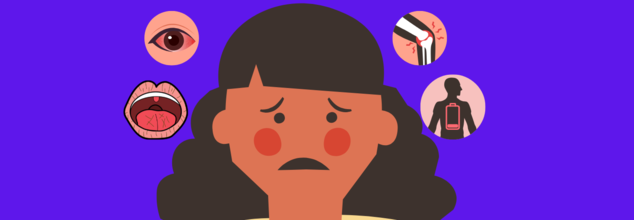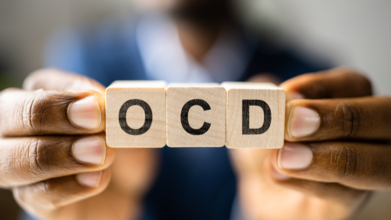- Health Conditions A-Z
- Health & Wellness
- Nutrition
- Fitness
- Health News
- Ayurveda
- Videos
- Medicine A-Z
- Parenting
- Web Stories
World Sjogren’s Day 2025: Why This “Mild” Autoimmune Condition Can Be Life-Altering

Credits: Canva
Sjögren’s Syndrome is one of the most common yet misunderstood autoimmune disorders in the world today. It’s often brushed off as a “dry eye and dry mouth” condition, but what many don’t realize is that this chronic, systemic illness can severely affect multiple organs—sometimes leading to irreversible complications. With July 23 marking World Sjögren’s Day, experts are urging for more awareness, earlier diagnosis, and a patient-first approach to treatment.
World Sjögren’s Day is observed every year on July 23, to honor Dr. Henrik Sjögren—the Swedish ophthalmologist who first identified the condition in 1933. The day is not just symbolic. It’s a global movement to educate the public, highlight patient voices, and push for research and policy changes.
The 2025 theme “Awareness Through Research” puts the spotlight on how patients—when given the space to share their experiences—can drive scientific breakthroughs and better clinical outcomes.
What is Sjogren's Disease?
Sjögren’s Disease is a chronic autoimmune disorder where the body’s immune system mistakenly attacks its own healthy cells—primarily the moisture-producing glands. Most commonly, this results in dry eyes and dry mouth, but Sjögren’s doesn’t stop there. It can also affect other parts of the body including the joints, lungs, kidneys, nerves, digestive system, and even the skin.
The condition is often misdiagnosed or diagnosed late because its symptoms—like fatigue, burning eyes, or trouble swallowing—are frequently dismissed as signs of aging, stress, or dehydration. That delay in diagnosis can be dangerous, since Sjögren’s is also linked to a higher risk of lymphoma, a type of cancer.
It affects an estimated 4 million people in the U.S., mostly women over 40, though it can occur at any age. While there is no cure, early detection and a coordinated care approach can significantly improve quality of life and prevent long-term damage.
In the U.S. alone, an estimated 4 million people live with Sjögren’s. Yet, for most patients, getting diagnosed takes 3 to 5 years, sometimes longer. Dr. Pawan Gupta, Senior Cataract & Retina Surgeon, explains why, “Symptoms like dry eyes, fatigue or dry mouth are so common, they’re often misattributed to dehydration, stress, screen time or aging. This leads to delayed referrals and misdiagnoses.”
That delay is costly, Sjögren’s doesn’t just stay in the eyes and mouth—it can quietly affect lungs, kidneys, nerves, joints and even increase the risk of lymphoma.
What are the early signs and symptoms of Sjogren’s Syndrome?
While every case is different, the most reported symptoms include:
- Persistent dry eyes or burning sensation
- Dry mouth and difficulty swallowing
- Chronic fatigue
- Joint pain
- Dental cavities or oral infections
- Vaginal dryness
- Brain fog or memory lapses
These may seem harmless at first—but when ignored, they point to a deeper autoimmune imbalance that can worsen with time.
Why Sjögren’s Isn’t Just a ‘Mild Autoimmune Condition’?
Sjogren’s Syndrome is often mistakenly believed to be a mild autoimmune disease because the early symptoms, dry eyes and dry mouth, seem harmless and are easily overlooked. Dr Pawan says, "This disease can be anything but minor. It is a systemic autoimmune disorder that results when the body's immune system attacks the glands that produce moisture, namely the lacrimal ) and salivary glands. This can lead to serious complications, involving multiple organs, over time, it goes from discomfort to widespread complications."
Sjogren's progresses to potentially affect the lungs, kidneys, joints, nerves, and gastrointestinal system. "Many patients also suffer from chronic fatigue, debilitating pain in their joints and an increased risk for lymphoma. The complexity of the condition may require a multi-specialty approach that involves a rheumatologist, ophthalmologist and pulmonologist. The perception that Sjogren’s is a benign condition, means that aggressive management is delayed and can potentially deprive patients of optimal quality of life. Time is of the essence for early intervention to stop irreversible damage, especially to the eyes and internal organs. Sjögren’s should be viewed as a serious, chronic and often progressive disease requiring long-term comprehensive care management," adds Dr Pawan.
Does Sjögren’s Syndrome Takes Years to Diagnose?
Sjögren’s Syndrome can take many years to identify, and Dr Gupta evidently explains, "Since the early symptoms of dry mouth, dry eyes, and mild fatigue could be easily ascribed to more common and easily explained reasons such as dehydration, adverse effects of medications, or just aging. Physicians might not think of the diagnosis of an autoimmune disorder without other obvious pertinent reasons or signs. In addition, these early symptoms might accompany other disorders and clinical conditions, making other relevant areas of differential diagnosis difficult."
Initially in their disease, most of the general physicians they visit would not recognize the underlying immune dysfunction and that treating the symptoms may be treating the symptoms only. Another aspect that doesn't make diagnosis easier is the process to obtain a definitive diagnosis. There is not a single definitive test for Sjögren’s. Most patients receive a diagnosis following a battery of lab tests, eye exams, imaging, or biopsies of salivary glands and extensive history, simultaneously and serologically completing the diagnostic picture. As Sjogren progresses slowly, there may not be systemic problems until much later in the disease, delaying diagnosis even longer.
"Delaying the diagnosis of Sjogren’s means the patients will suffer for a longer period and are at increased risk from complications due to it being an auto-immune disorder. Increasing awareness about early symptoms of patients and having physicians diagnosing and referring to rheumatologists may assist in achieving timely diagnosis and management of this complex disease," emphasises Dr Gupta.
Does Dry Eyes Become a Progressive, Permanent Risk for Sjögren’s Syndrome?
Yes, if untreated, dry eyes can become a progressive and potentially permanent problem for those with Sjogren's Syndrome. In Sjogren's Syndrome, the immune system attacks the lacrimal glands and dramatically decreases the production of tears. When that happens, the natural tear film that protects and nourishes your eye can become unstable, leading to certain ocular issues such as irritation, blurred vision, burning, and potentially corneal damage in long-standing situations.
As a result of untreated dryness, chronic dryness leads to long-term complications in many cases. Serious complications range from corneal ulcers, corneal infections, and lastly, permanent vision loss. Dr Gupta points out, "Treatment for dry eyes in Sjogren's starts with frequent artificial tear use to keep your eye surface moist. In more progressive cases, punctal plugs may assist in holding your natural tears by blocking the drainage through your tear ducts. It is important to follow up regularly with your eye care specialist. Since Sjogren's is progressive, it is good practice to take proactive and continued care of your eyes to preserve vision as well as prevent irreversible damage."
What are the Treatment Options for Sjögren’s today?
There is no cure, but a multi-specialty approach helps manage symptoms and slow progression:
For dry eyes: Artificial tears, prescription anti-inflammatories, punctal plugs
For dry mouth: Saliva substitutes, sugar-free lozenges, good oral hygiene, regular dental care
Systemic symptoms: Hydroxychloroquine, corticosteroids, immunosuppressants
Lifestyle adjustments: Hydration, humidifiers, avoiding triggers (like alcohol or caffeine), and pacing energy
Patients often need coordination between a rheumatologist, ophthalmologist, dentist, ENT and sometimes neurologist.
What makes the 2025 theme ‘Awareness Through Research’ important?
This year’s theme recognizes that real progress in Sjögren’s research has come from patients who speak up.
Their stories are shaping new clinical trials, earlier screening tools, and even new drug development. Salivary gland imaging, lab biomarkers, and tear analysis are all becoming more advanced thanks to this growing patient-led momentum.
If you're experiencing persistent dry eyes, dry mouth, or crushing fatigue, don’t dismiss it—and don’t let others dismiss it either. If symptoms don’t improve or begin to cluster, especially with joint pain or swelling, ask your doctor directly about a referral to a rheumatologist. Early intervention can change the course of this disease.
For doctors, it’s time to challenge the common assumptions. Not every case of dry eyes stems from excessive screen time or aging. If your patient presents with multiple vague, systemic complaints—dryness, fatigue, brain fog—consider Sjögren’s syndrome early, rather than as a diagnosis of exclusion.
For the public, awareness is everything. Most people with Sjögren’s don’t “look sick", but behind the scenes, they’re managing a complex, exhausting autoimmune condition daily. Sjögren’s may be quiet, but it’s not mild. It deserves sharper clinical attention, more robust support systems, and far greater visibility in the conversation around chronic illness.
Dr. Pawan Gupta, Senior Cataract & Retina Surgeon, Eye 7 Hospitals Lajpat Nagar & Vision Eye Clinic New Delhi
Microstress Is Real: These Tiny Terrors Are Quietly Wrecking Your Mental Health

We often associate stress with dramatic breakdowns, overwhelming work, or emotional turmoil. But what if the real danger lies in the tiny, everyday pressures we don’t even notice building up?
What Is Microstress and Why It Matters
“Stress is the most notorious yet underplayed disease,” says Alma Chopra, motivational speaker, disability rights activist and life coach. “It’s often thought of as an emotional onslaught that makes it difficult to function. But stress isn't just limited to our emotions; we can also become physically stressed from a chronic illness or an injury.”
Alma explains that microstresses are small, fleeting moments of stress that sneak into our daily routines. “Sometimes it creeps up through daily pressures until we hit our melting point. These are called microstresses,” she shares. These could include running late for a meeting or scrolling social media right after waking up. They may feel harmless in the moment but layer up to become chronic stress over time.
How Microstresses Mess With You
“These reactions feel minor and temporary, so they're quickly replaced by the next task or eased by a smiling face or a piece of cake,” says Alma. But the danger lies in how these minor stressors build up over time. “We tend to ignore these micro-stresses, but over time, they build low-level tension that will affect your sleep, focus, mood and health.”
Alma lists common microstressors and their effects:
- Alarm: “Jerks the body into a sudden state of alertness, disrupting natural rest.”
- Checking work email: “Doing this first thing in the morning puts us into a state of panic and anxiety.”
- Scrolling social media: “Overstimulates the brain and drains mental focus.”
- Confrontations: “Force us to deal with discomfort we’re not emotionally prepared for.”
- Unfinished tasks: “Juggling a long list without breaks builds pressure and leads to burnout.”
- Bruising your knee: “Even minor damage to the bone or soft tissue creates physical stress in the body.”
Alma advises recognising patterns and creating little routines to manage stress before it spirals. “Begin by recognising patterns, checking what drains you and creating little routines to relieve stress,” she says. “Start taking short breaks, creating boundaries and incorporating rejuvenating practices into your day.”
When Lifestyle Fuels Microstress
Sukirti Midha, spiritual wellness coach and founder of Sukh Yog, points out that microstress is a lifestyle issue. “Micro stress, as the name suggests, is small things we face as a working person or a householder. No gender age or designation we are discussing here; it’s the same for all,” she says.
According to Sukirti, “It’s in our lifestyle now; still, we are not aware of it.” She adds that people often don’t even feel it building up. “Do you think it happens overnight? No, nothing happens overnight except the sun comes out,” she jokes, adding a serious note that many people today don’t even see the sunrise, contributing to deficiencies like vitamin D.
Sukirti points out how society’s pressure to look good and maintain appearances feeds microstress. “When one gets conscious about looks, which include not only clothes but also touch-ups, make-up and hair. It’s not social pressure but created by us only.” She questions why people rely on external validation to feel good. “Why is it always important to look good to feel good?”
She also flags social media’s impact. “Many social media applications have filters to make you feel more beautiful and younger, which gives you plenty of stress when we look back in a basic mirror.” Comparing ourselves to others’ curated lives triggers a subtle but ongoing sense of inadequacy.
“Maintaining a status is a pressure these days,” she says. “Always remember as we shift from past to present or future to present, we learn happiness is about you & not the things or society status.”
The Simple Way Out
Both experts agree that while microstress can’t always be avoided, we can manage it better by slowing down, drawing boundaries and valuing simplicity. As Sukirti says, “Staying away from microstress isn’t easy, but preferring solace is an easy way out.”
Loving Perfection and Cleanliness Does Not Mean You Have OCD: Here Is What The Disorder Actually Means

If you have ever colour-coded your wardrobe, wiped the kitchen slabs repeatedly just because a speck of dust exists, or straightened a slightly off-centre painting on the wall, someone has probably laughed and said, I am so OCD too. But the thing is that you are probably not. And neither are they.
Somewhere along the way, we all misunderstood Obsessive Compulsive Disorder (OCD), a serious mental health condition, and casually said it. OCD has become shorthand for being neat, organised, or a lover of clean aesthetics. But as mental health professionals and those who actually live with OCD will tell you, that stereotype could not be further from the truth.
OCD is a clinically diagnosed anxiety disorder. It is not just about being extra clean or a control freak. It involves a cycle of obsessions, which are intrusive, unwanted thoughts and compulsions, which are repetitive behaviours or mental acts done to try to neutralise those thoughts.
Imagine being haunted by a constant fear that your loved one will die unless you tap the light switch exactly five times. Or being plagued by the thought that you have hit someone with your car, even though there is no evidence of it happening, and then going back to the same stretch of road again and again to check. That is the lived reality of OCD. It is not cute, it is not fun, and it definitely does not feel satisfying or neat.
The Cleanliness Myth
Yes, some people with OCD have cleanliness-related compulsions. But not everyone with OCD is a neat freak, and not all neat freaks have OCD. The need to wash your hands repeatedly until they are raw is not about loving cleanliness; it is about desperately trying to get rid of a feeling that something is terribly wrong. Often, the compulsion is not even rationally linked to the obsession. It is about trying to regain control over overwhelming anxiety, even if only temporarily.
In fact, OCD themes can be disturbingly varied, from fears of harming others to taboo thoughts to symmetry to morality. The common thing is that the thoughts are distressing, the anxiety is debilitating, and the rituals are exhausting.
Why It is Harmful To Mislabel Yourself As “OCD”
Calling yourself “OCD” because you like your stuff arranged by colour might seem harmless. But this kind of throwaway comment does a real disservice to people living with the actual condition. It trivialises their experiences and contributes to misinformation.
It also prevents those who might truly be struggling with OCD from recognising their symptoms and seeking help. Because if society keeps painting OCD as a personality problem, why would anyone think it is a serious problem?
What OCD Actually Feels Like
Ask anyone with OCD, and they will tell you it is not fun. It is not satisfying to double-check the lock for the 17th time. It is not enjoyable to feel like you are going to vomit because of a thought you did not ask for and cannot get rid of. It is a relentless loop of “what ifs” and “just in cases” that can take over your entire life.
OCD can interfere with relationships, work, sleep, and basic daily functioning. It is often accompanied by shame and secrecy because people worry others would not understand, or worse, will think they are dangerous or irrational.
Time To Rethink The Label
You might just be tidy. Or meticulous. Or even perfectionistic. And that is fine. But OCD? That is a diagnosis. A tough, often debilitating one that deserves respect. If you think you might actually have OCD, then help is available. Cognitive Behavioural Therapy (CBT), particularly Exposure and Response Prevention (ERP), has been proven to be effective. But it starts with understanding what OCD really is.
World IVF Day: What Makes The IVF Journey So Hard On The Mind?

In vitro fertilisation (IVF) is not just about science, syringes and success rates. What lies behind the walls of fertility clinics is a deeply personal journey filled with hope, heartbreak and resilience, making it more than just a medical procedure. Beyond the social taboos, infertility brings huge stress to the patients. And while IVF offers hope, it does not come easy. It is a rollercoaster ride that patients experience as they take on the road to this procedure; highs and lows can take a severe mental toll on them.
However, for those unversed, infertility has been classified by the World Health Organisation as a disease like diabetes or hypertension; the social taboo around it still persists. Over the years, advancements in reproductive science have made IVF treatments more patient-friendly and significantly improved outcomes. Yet, the focus often leans heavily on science, expertise and clinic proficiency, while the mental and emotional toll on the couple is overlooked.
For many, the psychological impact of IVF can match that of the death of a family member or going through a divorce. Although many people find IVF very stressful, every patient experiences it differently. Personalities and life experiences play a big role in determining how one handles the process and what part of IVF they find most difficult.
Why Is IVF So Emotionally Draining?
We ask an expert to break down several key factors that contribute to the immense stress IVF brings:
- Uncertainty of Outcomes
- Physical Strain
- Societal Pressure
- Guilt and Shame
- Depression After Failed Attempts
- Relationship Strain
Learning to Cope with Support Systems That Help
There is light at the end of the tunnel, and as Dr Saple says, there are several strategies that can help couples better cope with the IVF process.
- Psychological Counselling
- Support Groups
- Mind–Body Practices
Setting Realistic Expectations
“IVF may take more than one cycle to succeed,” she explains. Being mentally prepared for the outcome, while knowing you have done your best, helps couples accept results with resilience.
It is Okay to Ask for Help
As Dr Saple reminds us, mental and emotional health are as important as physical health during IVF. Prioritising emotional wellbeing not only makes the journey more bearable but can also improve the overall outcome. “Seeking help is a sign of strength, not weakness,” she says.
© 2024 Bennett, Coleman & Company Limited

